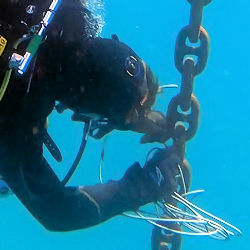29.J Underwater Blasting.
29.J.01 A blaster must conduct all blasting operations. The shot must not be fired without his approval.
29.J.02 Loading tubes and casings of dissimilar metals must not be used because of possible electric transient currents from galvanic action of the metals and water.
29.J.03 Only water-resistant blasting caps and detonating cords must be used for all marine blasting. Loading must be done through a non-sparking metal loading tube when necessary.
29.J.04 Blasting flags must be displayed.
29.J.05 The storage and handling of explosive materials aboard vessels used in underwater blasting operations must be according to provisions in Sections 29.A and 29.C.
29.J.06 When more than one hole is loaded to be fired underwater, a steel shot line must be anchored and floated over the row of loaded holes.
- The detonation down line from each loaded hole must be tied to the steel line and the loose end must be tied to the detonation trunk line.
- After the trunk line fires, the steel shot line must be inspected for misfires. Misfires must be handled in accordance with the requirements of Section 29.I.05.
29.J.07 When drilling near or adjacent to a loaded hole, drilling must be limited to vertical holes only. Drilling must be separated from loaded holes by the depth of water plus the depth of the loaded hole.
- If a solid casing or drill mast - vertically plumbed with an inclinometer - is extended from the barge and firmly seated on bedrock, the distance between a loaded hole and one being drilled must be 1/3 the depth of the hole, with a minimum of 8 ft (2.4 m) between the loaded hole and the one being drilled.
- Drilling must be halted to check alignment with an inclinometer every 4 ft (1.2 m) of hole depth.
Knowledge Check Choose the best answer for the question.
29-14. What is required when conducting underwater blasting operations?
You forgot to answer the question!

